 Illustration by Gareth A Hopkins
Illustration by Gareth A Hopkins
Walking into Sue Timney’s retrospective at the Fashion and Textile Museum, visit this site the viewer is greeted by the almost blinding black and white pattern that the company, Timney-Fowler, is known for. The relationship between Timney’s application of pattern and Op art are undeniable, the entire exhibition acts as an homage to one of the most vibrant elements of painting in Modern Art’s history.
The main room of the exhibition is dominated by an explosion of chairs, reminiscent of what Alice’s fall through the rabbit hole would have looked like if crossed with Beetlejuice. The ideas, sketches and prints of Timney-Fowler adorn the walls and the products the company produced (everything from pencil cases to china).
The vibrancy of Pop Art’s interpretation of household objects inspired the reoccurring motif of everyday objects, with some of the prints being described as “A design stream of consciousness” and “an extension of the sketchbook into an individualist statement.”
Upstairs, the exhibition wonderfully included Timney’s sketchbooks, personally nothing is more insightful than a glimpse into an artist’s sketches. Timney’s interpretation of the history of modern art within her designs preempts the recent revival of designers using specific artists within their catwalk collections.
Timney’s incredible application of print to all objects belies Timney’s background in sculpture and printmaking, which was in fact the rather wonderful sounding Interdisciplinary Tapestry Course, sadly as the Government’s proposed cuts land on Universities doorsteps, technicians and idiosyncratic courses will be one of the first things cut by Art departments.
This exhibition is a wonderful insight into the progress of Sue Timney from artist to product design to interior designer and for anyone intrigued by the process of artistic design.
My visit last week to the Fashion and Textile Museum compounded my sense of Governmental shortsightedness with regards to Higher Education and the humanities in particular. To compound the rise in tuition fees, the Coalition are suggesting the removal of up to 80% of the State funding Universities receive to subsidise the teaching of Humanities.
It over a month ago now that the first students protest took to the street, in the weeks since students and UK Uncut have taken their opposition to the Government’s austerity drive onto to the pavement. and occupied (most of the occupations have now ended) rooms within their University in protest against the Coalition’s Government’s motion to rise tuition fees. Sadly the motion was passed last week in the Commons and yesterday in the House of Lords.
 Illustration by Gareth A Hopkins
Illustration by Gareth A Hopkins
Walking into Sue Timney’s retrospective at the Fashion and Textile Museum, viagra sale the viewer is greeted by the almost blinding black and white pattern that the company, Timney-Fowler, is known for. The relationship between Timney’s application of pattern and Op art are undeniable, the entire exhibition acts as an homage to one of the most vibrant elements of painting in Modern Art’s history.
The main room of the exhibition is dominated by an explosion of chairs, reminiscent of what Alice’s fall through the rabbit hole would have looked like if crossed with Beetlejuice. The ideas, sketches and prints of Timney-Fowler adorn the walls and the products the company produced (everything from pencil cases to china).
The vibrancy of Pop Art’s interpretation of household objects inspired the reoccurring motif of everyday objects, with some of the prints being described as “A design stream of consciousness” and “an extension of the sketchbook into an individualist statement.”
Upstairs, the exhibition wonderfully included Timney’s sketchbooks, personally nothing is more insightful than a glimpse into an artist’s sketches. Timney’s interpretation of the history of modern art within her designs preempts the recent revival of designers using specific artists within their catwalk collections.
Timney’s incredible application of print to all objects belies Timney’s background in sculpture and printmaking, which was in fact the rather wonderful sounding Interdisciplinary Tapestry Course, sadly as the Government’s proposed cuts land on Universities doorsteps, technicians and idiosyncratic courses will be one of the first things cut by Art departments.
This exhibition is a wonderful insight into the progress of Sue Timney from artist to product design to interior designer and for anyone intrigued by the process of artistic design.
My visit last week to the Fashion and Textile Museum compounded my sense of Governmental shortsightedness with regards to Higher Education and the humanities in particular. To compound the rise in tuition fees, the Coalition are suggesting the removal of up to 80% of the State funding Universities receive to subsidise the teaching of Humanities.
It over a month ago now that the first students protest took to the street, in the weeks since students and UK Uncut have taken their opposition to the Government’s austerity drive onto to the pavement. and occupied (most of the occupations have now ended) rooms within their University in protest against the Coalition’s Government’s motion to rise tuition fees. Sadly the motion was passed last week in the Commons and yesterday in the House of Lords.
 Illustration by Gareth A Hopkins
Illustration by Gareth A Hopkins
Upon walking into Sue Timney’s retrospective at the Fashion and Textile Museum, sales the viewer is greeted by the almost blinding black and white pattern that Sue’s company in collaboration with Grahame Fowler; Timney-Fowler, cialis 40mg is best known for. The relationship between Timney’s application of pattern and Op art are undeniable, online the entire exhibition acts as an homage to one of the most vibrant elements of painting in Modern Art’s history.
The main room of the exhibition is dominated by an explosion of chairs, reminiscent of what Alice’s fall through the rabbit hole would have looked like if crossed with Beetlejuice. The ideas, sketches and prints of Timney-Fowler adorn both the walls of the Fashion and Textile Museum as well as the products produced by the company (everything from pencil cases to china).
The vibrancy of Pop Art’s interpretation of household objects inspired the reoccurring motif of everyday objects, with some of the prints being described as “A design stream of consciousness” and “an extension of the sketchbook into an individualist statement.”
Upstairs, the exhibition wonderfully included Timney’s sketchbooks, personally nothing is more insightful than a glimpse into an artist’s sketches. Timney’s interpretation of the history of modern art within her designs preempts the recent revival of designers using specific artists within their catwalk collections.
Timney’s incredible application of print to all objects belies Timney’s background in sculpture and printmaking, which was in fact the rather wonderful sounding Interdisciplinary Tapestry Course, sadly as the Government’s proposed cuts land on Universities doorsteps, technicians and idiosyncratic courses will be one of the first things cut by Art departments.
This exhibition is a wonderful insight into the progress of Sue Timney from artist to product design to interior designer and for anyone intrigued by the process of artistic design.
My visit last week to the vibrant and incredibly innovative Sue Tinmey exhibition at Fashion and Textile Museum compounded my sense of the cuts to Higher Education teaching -the Humanities in particular- the Government intend to make are incredibly shortsighted, for they fail not only to take into account the continual impact these graduates have on the economy, but they appear to place all importance on quick money making results rather than on a through education.
Sue Tinmey and the design of Timney-Fowler is at the Fashion and Textile Museum until 25th April 2011.
 Illustration by Gareth A Hopkins
Illustration by Gareth A Hopkins
Upon walking into Sue Timney’s retrospective at the Fashion and Textile Museum, buy the viewer is greeted by the almost blinding black and white pattern that Sue’s company in collaboration with Grahame Fowler; Timney-Fowler, website like this is best known for. The relationship between Timney’s application of pattern and Op art are undeniable, information pills the entire exhibition acts as an homage to one of the most vibrant elements of painting in Modern Art’s history.
The main room of the exhibition is dominated by an explosion of chairs, reminiscent of what Alice’s fall through the rabbit hole would have looked like if crossed with Beetlejuice. The ideas, sketches and prints of Timney-Fowler adorn both the walls of the Fashion and Textile Museum as well as the products produced by the company (everything from pencil cases to china).
The vibrancy of Pop Art’s interpretation of household objects inspired the reoccurring motif of everyday objects, with some of the prints being described as “A design stream of consciousness” and “an extension of the sketchbook into an individualist statement.”
Upstairs, the exhibition wonderfully included Timney’s sketchbooks, personally nothing is more insightful than a glimpse into an artist’s sketches. Timney’s interpretation of the history of modern art within her designs preempts the recent revival of designers using specific artists within their catwalk collections.
Timney’s incredible application of print to all objects belies her background in sculpture and printmaking, which was in fact the rather wonderful sounding Interdisciplinary Tapestry Course, sadly as the Government’s proposed cuts land on Universities doorsteps, technicians and idiosyncratic courses will be one of the first things cut by Art departments.
 Illustration by Alia Gargum
Illustration by Alia Gargum
This exhibition is a wonderful insight into the progress of Sue Timney from artist to product design to interior designer and for anyone intrigued by the process of artistic design.
My visit last week to the vibrant and incredibly innovative Sue Tinmey exhibition at Fashion and Textile Museum compounded my sense of the cuts to Higher Education teaching -the Humanities in particular- the Government intend to make are incredibly shortsighted, for they fail not only to take into account the continual impact these graduates have on the economy, but they appear to place all importance on quick money making results rather than on a through education.
Sue Tinmey and the design of Timney-Fowler is at the Fashion and Textile Museum until 25th April 2011.
 Illustration by Gareth A Hopkins
Illustration by Gareth A Hopkins
Upon walking into Sue Timney’s retrospective at the Fashion and Textile Museum, page the viewer is greeted by the almost blinding black and white pattern that Sue’s company in collaboration with Grahame Fowler; Timney-Fowler, is best known for. The relationship between Timney’s application of pattern and Op art are undeniable, the entire exhibition acts as an homage to one of the most vibrant elements of painting in Modern Art’s history.
The main room of the exhibition is dominated by an explosion of chairs, reminiscent of what Alice’s fall through the rabbit hole would have looked like if crossed with Beetlejuice. The ideas, sketches and prints of Timney-Fowler adorn both the walls of the Fashion and Textile Museum as well as the products produced by the company (everything from pencil cases to china).
 Illustration by Avril Kelly
Illustration by Avril Kelly
The vibrancy of Pop Art’s interpretation of household objects inspired the reoccurring motif of everyday objects, with some of the prints being described as “a design stream of consciousness” and “an extension of the sketchbook into an individualist statement.”
Upstairs, the exhibition wonderfully included Timney’s sketchbooks, personally nothing is more insightful than a glimpse into an artist’s sketches. Timney’s interpretation of the history of modern art within her designs preempts the recent revival of designers using specific artists within their catwalk collections.
Timney’s incredible application of print to all objects belies her background in sculpture and printmaking, which was in fact the rather wonderful sounding Interdisciplinary Tapestry Course, sadly as the Government’s proposed cuts land on Universities doorsteps, technicians and idiosyncratic courses will be one of the first things cut by Art departments.
 Illustration by Alia Gargum
Illustration by Alia Gargum
This exhibition is a wonderful insight into the progress of Sue Timney from artist to product design to interior designer and for anyone intrigued by the process of artistic design.
My visit last week to the vibrant and incredibly innovative Sue Tinmey exhibition at Fashion and Textile Museum compounded my sense of the cuts to Higher Education teaching -the Humanities in particular- the Government intend to make are incredibly shortsighted, for they fail not only to take into account the continual impact these graduates have on the economy, but they appear to place all importance on quick money making results rather than on a through education.
Sue Tinmey and the design of Timney-Fowler is at the Fashion and Textile Museum until 25th April 2011.
 Illustration by Gareth A Hopkins
Illustration by Gareth A Hopkins
Upon walking into Sue Timney’s retrospective at the Fashion and Textile Museum, sildenafil the viewer is greeted by the almost blinding black and white pattern that Sue’s company in collaboration with Grahame Fowler; Timney-Fowler, is best known for. The relationship between Timney’s application of pattern and Op art are undeniable, the entire exhibition acts as an homage to one of the most vibrant elements of painting in Modern Art’s history.
The main room of the exhibition is dominated by an explosion of chairs, reminiscent of what Alice’s fall through the rabbit hole would have looked like if crossed with Beetlejuice. The ideas, sketches and prints of Timney-Fowler adorn both the walls of the Fashion and Textile Museum as well as the products produced by the company (everything from pencil cases to china).
 Illustration by Avril Kelly
Illustration by Avril Kelly
The vibrancy of Pop Art’s interpretation of household objects inspired the reoccurring motif of everyday objects, with some of the prints being described as “a design stream of consciousness” and “an extension of the sketchbook into an individualist statement.”
Upstairs, the exhibition wonderfully included Timney’s sketchbooks, personally nothing is more insightful than a glimpse into an artist’s sketches. Timney’s interpretation of the history of modern art within her designs preempts the recent revival of designers using specific artists within their catwalk collections.
Timney’s incredible application of print to all objects belies her background in sculpture and printmaking, which was in fact the rather wonderful sounding Interdisciplinary Tapestry Course, sadly as the Government’s proposed cuts land on Universities doorsteps, technicians and idiosyncratic courses will be one of the first things cut by Art departments.
 Illustration by Alia Gargum
Illustration by Alia Gargum
This exhibition is a wonderful insight into the progress of Sue Timney from artist to product design to interior designer and for anyone intrigued by the process of artistic design.
My visit last week to the vibrant and incredibly innovative Sue Tinmey exhibition at Fashion and Textile Museum compounded my sense of the cuts to Higher Education teaching -the Humanities in particular- the Government intend to make are incredibly shortsighted, for they fail not only to take into account the continual impact these graduates have on the economy, but they appear to place all importance on quick money making results rather than on a through education.
Sue Tinmey and the design of Timney-Fowler is at the Fashion and Textile Museum until 25th April 2011.
 Illustration by Gareth A Hopkins
Illustration by Gareth A Hopkins
Upon walking into Sue Timney’s retrospective at the Fashion and Textile Museum, pilule the viewer is greeted by the almost blinding black and white pattern that Sue’s company in collaboration with Grahame Fowler; Timney-Fowler, more about is best known for. The relationship between Timney’s application of pattern and Op art are undeniable, the entire exhibition acts as an homage to one of the most vibrant elements of painting in Modern Art’s history.
The main room of the exhibition is dominated by an explosion of chairs, reminiscent of what Alice’s fall through the rabbit hole would have looked like if crossed with Beetlejuice. The ideas, sketches and prints of Timney-Fowler adorn both the walls of the Fashion and Textile Museum as well as the products produced by the company (everything from pencil cases to china).
 Illustration by Avril Kelly
Illustration by Avril Kelly
The vibrancy of Pop Art’s interpretation of household objects inspired the reoccurring motif of everyday objects, with some of the prints being described as “a design stream of consciousness” and “an extension of the sketchbook into an individualist statement.”
Upstairs, the exhibition wonderfully included Timney’s sketchbooks, personally nothing is more insightful than a glimpse into an artist’s sketches. Timney’s interpretation of the history of modern art within her designs preempts the recent revival of designers using specific artists within their catwalk collections.
Timney’s incredible application of print to all objects belies her background in sculpture and printmaking, which was in fact the rather wonderful sounding Interdisciplinary Tapestry Course, sadly as the Government’s proposed cuts land on Universities doorsteps, technicians and idiosyncratic courses will be one of the first things cut by Art departments.
 Illustration by Alia Gargum
Illustration by Alia Gargum
This exhibition is a wonderful insight into the progress of Sue Timney from artist to product design to interior designer and for anyone intrigued by the process of artistic design.
My visit last week to the vibrant and incredibly innovative Sue Timney exhibition at Fashion and Textile Museum compounded my sense of the cuts to Higher Education teaching -the Humanities in particular- the Government intend to make are incredibly shortsighted, for they fail not only to take into account the continual impact these graduates have on the economy, but they appear to place all importance on quick money making results rather than on a through education.
Sue Timney and the design of Timney-Fowler is at the Fashion and Textile Museum until 25th April 2011.
 Illustration by Gareth A Hopkins
Illustration by Gareth A Hopkins
Upon walking into Sue Timney’s retrospective at the Fashion and Textile Museum, what is ed the viewer is greeted by the almost blinding black and white pattern that Sue’s company in collaboration with Grahame Fowler; Timney-Fowler, is best known for. The relationship between Timney’s application of pattern and Op art are undeniable, the entire exhibition acts as an homage to one of the most vibrant elements of painting in Modern Art’s history.
The main room of the exhibition is dominated by an explosion of chairs, reminiscent of what Alice’s fall through the rabbit hole would have looked like if crossed with Beetlejuice. The ideas, sketches and prints of Timney-Fowler adorn both the walls of the Fashion and Textile Museum as well as the products produced by the company (everything from pencil cases to china).
 Illustration by Avril Kelly
Illustration by Avril Kelly
The vibrancy of Pop Art’s interpretation of household objects inspired the reoccurring motif of everyday objects, with some of the prints being described as “a design stream of consciousness” and “an extension of the sketchbook into an individualist statement.”
Upstairs, the exhibition wonderfully included Timney’s sketchbooks, personally nothing is more insightful than a glimpse into an artist’s sketches. Timney’s interpretation of the history of modern art within her designs preempts the recent revival of designers using specific artists within their catwalk collections.
Timney’s incredible application of print to all objects belies her background in sculpture and printmaking, which was in fact the rather wonderful sounding Interdisciplinary Tapestry Course, sadly as the Government’s proposed cuts land on Universities doorsteps, technicians and idiosyncratic courses will be one of the first things cut by Art departments.
 Illustration by Alia Gargum
Illustration by Alia Gargum
This exhibition is a wonderful insight into the progress of Sue Timney from artist to product design to interior designer and for anyone intrigued by the process of artistic design.
My visit last week to the vibrant and incredibly innovative Sue Tinmey exhibition at Fashion and Textile Museum compounded my sense of the cuts to Higher Education teaching -the Humanities in particular- the Government intend to make are incredibly shortsighted, for they fail not only to take into account the continual impact these graduates have on the economy, but they appear to place all importance on quick money making results rather than on a through education.
Sue Tinmey and the design of Timney-Fowler is at the Fashion and Textile Museum until 25th April 2011.
 Illustration by Gareth A Hopkins
Illustration by Gareth A Hopkins
Upon walking into Sue Timney’s retrospective at the Fashion and Textile Museum, viagra 100mg the viewer is greeted by the almost blinding black and white pattern that Sue’s company in collaboration with Grahame Fowler; Timney-Fowler, is best known for. The relationship between Timney’s application of pattern and Op art are undeniable, the entire exhibition acts as an homage to one of the most vibrant elements of painting in Modern Art’s history.
The main room of the exhibition is dominated by an explosion of chairs, reminiscent of what Alice’s fall through the rabbit hole would have looked like if crossed with Beetlejuice. The ideas, sketches and prints of Timney-Fowler adorn both the walls of the Fashion and Textile Museum as well as the products produced by the company (everything from pencil cases to china).
 Illustration by Avril Kelly
Illustration by Avril Kelly
The vibrancy of Pop Art’s interpretation of household objects inspired the reoccurring motif of everyday objects, with some of the prints being described as “a design stream of consciousness” and “an extension of the sketchbook into an individualist statement.”
Upstairs, the exhibition wonderfully included Timney’s sketchbooks, personally nothing is more insightful than a glimpse into an artist’s sketches. Timney’s interpretation of the history of modern art within her designs preempts the recent revival of designers using specific artists within their catwalk collections.
Timney’s incredible application of print to all objects belies her background in sculpture and printmaking, which was in fact the rather wonderful sounding Interdisciplinary Tapestry Course, sadly as the Government’s proposed cuts land on Universities doorsteps, technicians and idiosyncratic courses will be one of the first things cut by Art departments.
 Illustration by Alia Gargum
Illustration by Alia Gargum
This exhibition is a wonderful insight into the progress of Sue Timney from artist to product design to interior designer and for anyone intrigued by the process of artistic design.
My visit last week to the vibrant and incredibly innovative Sue Tinmey exhibition at Fashion and Textile Museum compounded my sense of the cuts to Higher Education teaching -the Humanities in particular- the Government intend to make are incredibly shortsighted, for they fail not only to take into account the continual impact these graduates have on the economy, but they appear to place all importance on quick money making results rather than on a through education.
Sue Tinmey and the design of Timney-Fowler is at the Fashion and Textile Museum until 25th April 2011.
 Illustration by Gareth A Hopkins
Illustration by Gareth A Hopkins
Upon walking into Sue Timney’s retrospective at the Fashion and Textile Museum, pills the viewer is greeted by the almost blinding black and white pattern that Sue’s company in collaboration with Grahame Fowler; Timney-Fowler, ambulance is best known for. The relationship between Timney’s application of pattern and Op art are undeniable, the entire exhibition acts as an homage to one of the most vibrant elements of painting in Modern Art’s history.
The main room of the exhibition is dominated by an explosion of chairs, reminiscent of what Alice’s fall through the rabbit hole would have looked like if crossed with Beetlejuice. The ideas, sketches and prints of Timney-Fowler adorn both the walls of the Fashion and Textile Museum as well as the products produced by the company (everything from pencil cases to china).
 Illustration by Avril Kelly
Illustration by Avril Kelly
The vibrancy of Pop Art’s interpretation of household objects inspired the reoccurring motif of everyday objects, with some of the prints being described as “a design stream of consciousness” and “an extension of the sketchbook into an individualist statement.”
Upstairs, the exhibition wonderfully included Timney’s sketchbooks, personally nothing is more insightful than a glimpse into an artist’s sketches. Timney’s interpretation of the history of modern art within her designs preempts the recent revival of designers using specific artists within their catwalk collections.
Timney’s incredible application of print to all objects belies her background in sculpture and printmaking, which was in fact the rather wonderful sounding Interdisciplinary Tapestry Course, sadly as the Government’s proposed cuts land on Universities doorsteps, technicians and idiosyncratic courses will be one of the first things cut by Art departments.
 Illustration by Alia Gargum
Illustration by Alia Gargum
This exhibition is a wonderful insight into the progress of Sue Timney from artist to product design to interior designer and for anyone intrigued by the process of artistic design.
My visit last week to the vibrant and incredibly innovative Sue Tinmey exhibition at Fashion and Textile Museum compounded my sense of the cuts to Higher Education teaching -the Humanities in particular- the Government intend to make are incredibly shortsighted, for they fail not only to take into account the continual impact these graduates have on the economy, but they appear to place all importance on quick money making results rather than on a through education.
Sue Tinmey and the design of Timney-Fowler is at the Fashion and Textile Museum until 25th April 2011.
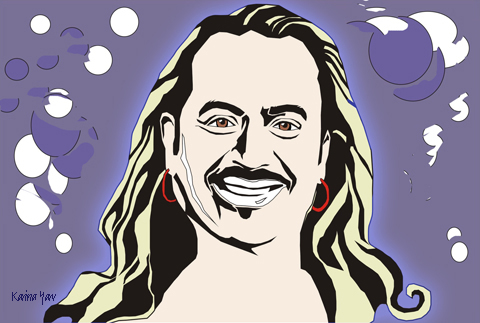
Wagner by Karina Yarv.
Another year, pills another X Factor out of the way. I went through a period of not watching any telly at all, advice and oh how I used to poo poo this show, buy but then, in 2009 I got sucked in. It was the only break I used to allow myself as I was creating my first book Amelia’s Anthology of Illustration – a bit of enjoyably vacuous pop culture on a plate. And it was then that I discovered the joy of X Factor watched with my twitter stream open. Trying to think of the bitchiest tweets as fast as possible has now become a something of a national sport, and I thoroughly recommend you do both at the same time once the whole bloody thing rolls around again next year.

X-Factor_Dannii Minogue wearing J’Aton Couture by Krister Selin
As for the final outcome? I couldn’t stand Cher Lloyd’s sneery face but thought her final effort was at least IN TUNE, whilst even on the same note the One Direction cuties struggled (harmonies, what are they?)
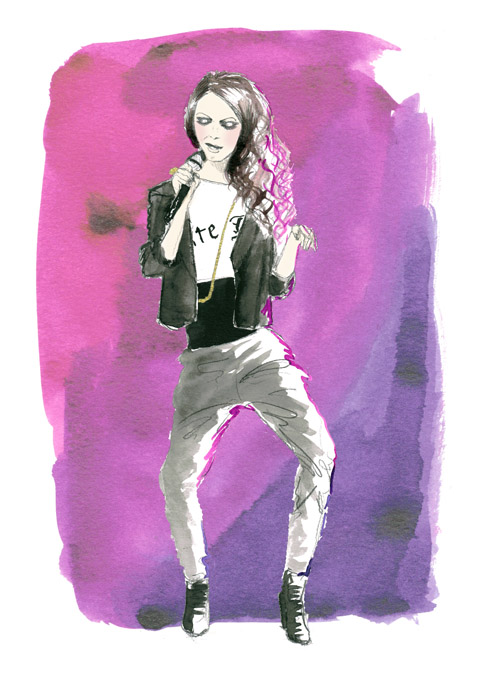
Cher Lloyd by Dee Andrews.
I loved Rebecca Ferguson’s voice until it started to grate on my nerves, as did the fact that she could not move, even singing the danciest of songs. I quite enjoyed some of Matt Cardle’s songs, but he was clearly not on form during the last few weeks. All in all, as could be predicted, I’ve heard better singers at small indie gigs.
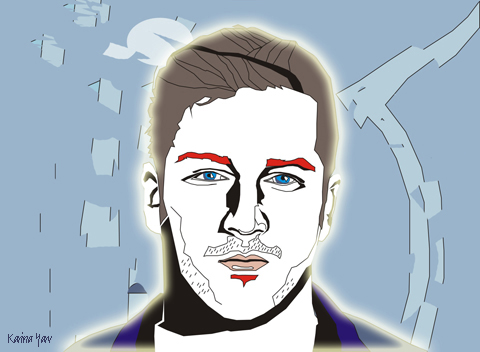
Matt Cardle by Karina Yarv
My fave live performance by Matt:

What really grabs the audience is of course the whole spectacle – the cliched dramatisations of the contestant’s back stories, the ridiculously over the top stage effects and the outrageously expensive outfits and stupendous styling choices of the judges and contestants. Here, then, is a chance to revel in the sheer glory of the X Factor experience, as seen through illustrators’ eyes.

The Lovechild of Jordan, Minnie Mouse and Jimmy Saville. Illustration by Abigail Daker.
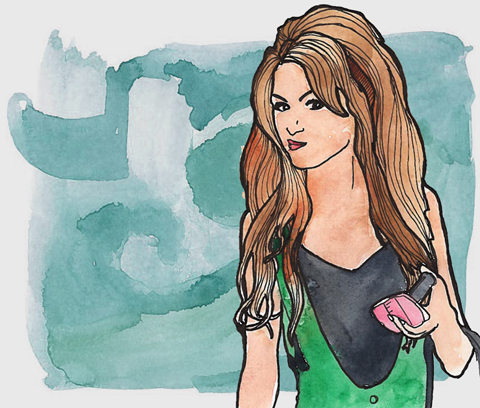
Cher Lloyd by Gareth A Hopkins.
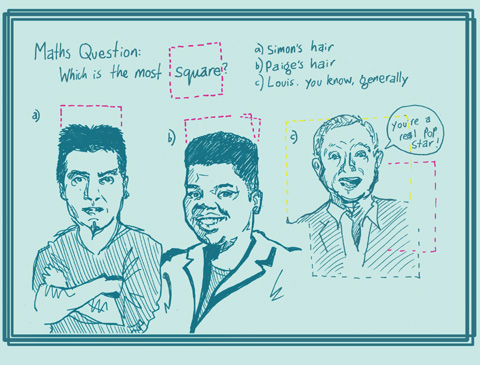
Illustration by Jenny Robins.

Katie Waissel by Karina Yarv

Cher Lloyd by Antaya Lendore

Wagbo (a character from Harry Hill’s TV Burp that was supposedly the love child of Wagner and Tesco Mary) by Gareth A Hopkins

X-Factor_Rebecca Ferguson wearing Lisa Marie Fernandez by Krister Selin

Wagner by Elliott Quince.

Katie Waissel and Rebecca Ferguson by Ellie Sutton

Cheryl Cole by Antaya Lendore.

Cher Lloyd by Gemma Pharo
Categories ,Abigail Daker, ,Antaya Lendore, ,Cher Lloyd, ,Dee Andrews, ,Ellie Sutton, ,Elliott Quince, ,Gareth A H, ,Gareth A Hopkins, ,Gemma Pharo, ,J’Aton Couture, ,Jenny Robins, ,Karina Yarv, ,Katie Waissel, ,Krister Selin, ,Lisa Marie Fernandez, ,Matt Cardle, ,One Direction, ,Rebecca Ferguson, ,Tesco Mary, ,Wagner, ,X Factor
Similar Posts:
- X Factor 2011: An Illustrated Retrospective
- London Fashion Week S/S 2011 Catwalk Review: Charles Anastase
- London Fashion Week S/S 2012 Menswear Day Catwalk Review: KTZ
- London Fashion Week S/S 2011 Catwalk Review: David Koma (Reprise)
- London Fashion Week A/W 2011 Menswear Day Catwalk Review: Cassette Playa



